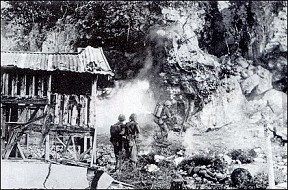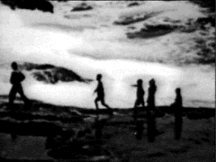 Saipan,
the Last Days of the battle Saipan,
the Last Days of the battle
Bill Hoover
My wife is the only person I have ever told about what happened
one afternoon in combat during the closing days of the battle for Saipan.
On July 11th 1944, my Platoon was ordered to move down the beach about
twenty yards off shore. Our orders were to strafe and shell any caves
that opened into the ocean, where we knew Japanese soldiers had taken
positions . A Marine infantryman on shore pointed to a cave a few yards
ahead, and said he saw about 20 or 30 soldiers wade into the cave. It
was high tide and the water was about 4 feet deep going into the cave.
The entrance was about 10 yards across, and we could see that it went
in
| several yards, then angled to the right at about
45 degrees. My Tank Commander, Sgt Wallace Johnson said it would
do little good to use machine guns, so as gunner I was told to open
fire with our 75mm canon. I fired off 4 or 5 rounds and we could
hear people screaming inside the cave. We ceased fire and asked |

Marine flame throwers
burn the last Japanese Soldiers out of similar caves on Saipan
|
and yelled for anyone inside to please come out and surrender. Instead,
we received machine gun and rifle fire, as well as a couple of hand grenades.
I fired in another 10 or 15 rounds of 75mm HE; then we were told a team
of Marines were going to go in and make sure it was secure. At this time,
the water flowing out of the cave was red with blood. When the infantry
team came back out they reported there were at least 50 Japanese soldiers
as well as a dozen or so civilians, all dead . Some of the civilians were
women, who were not allowed to surrender to us , under threat of being
killed by the Jap soldiers. I regret to this day we had to take the action
we did, but we could not leave a enemy force at our backs. Nor would I
now.
Editor's note: At this time of the war, Japanese soldiers and
civilians were convinced by propaganda that U.S. Marines were such monsters
that they should die rather than surrender. This resulted in a horror
that few Marines can forget. Saipan was declared secure on July 9. Like
Bill's story, however, the final page had not been written. Japanese
hold-outs remained in caves and bunkers throughout. They had to be removed.
This "mopping up" was a painful and dangerous job.
The final horror came well after the worse of the fighting was
over. On the northern tip of the island was Marpi Point, a plateau more
than 800 feet above a jagged coral rock shore. Hundreds of Japanese
civilians joined the few remaining Japanese troops in an orgy of self
- destruction.
|

Actual photo of Japanese civilians
running to the cliffs.
|
Marines used loudspeakers to broadcast
assurances in Japanese that they would treat captives well to no
avail. Japanese families threw their small children off the cliffs
then jumped after them. Whole families waded together out to sea
to drown themselves. One particular group of about 100 bowed to
Marines watching, incredulously, from a cliff. They stripped, bathed,
donned fresh clothing and spread a |
Japanese flag out. One distributed hand grenades. One by one they
pulled the pins and held the grenades against their bellies.
Saipan, secured by the US Marines on July 9, 1944, was located
within air striking distance of Japan.
On a lighter note
On the day Saipan was declared "officially secured', my Platoon
bedded down in a clump of trees a hundred or so yards in from the beach.
We knew there were still Japanese soldiers roaming around raising hell,
but we thought we were in a pretty safe area. It started to rain a little
after dark, so I tied a rope around each end of a poncho and strung
it between two trees like a hammock. When I was ready to turn in, I
pulled myself up into the poncho, laid my carbine across by chest and
wrapped the sides around me the best I could. About 2300 it was pouring
down rain, and I heard someone shout "there's a Jap", then
a half a dozen shots rang out. It was completely dark, and I could barely
make out a figure running towards me. I tried to get out of the damn
poncho, but I was tangled in the rope, and in my panic I couldn't get
free. About this time I heard the click of a grenade, then a thud somewhere
beneath me. I still couldn't get out of the damn poncho so I braced
myself for the explosion. Nothing happened, then I heard someone say,
"I got him", The next morning I was able to get out of the
hammock and looked underneath. There was a Japanese hand grenade, laying
right under where my butt would have been, and it just didn't go off.
From then on, I slept in a fighting hole like everyone else, rain or
not. As a matter of fact, I have never been in a hammock since.
Semper Fi,
Bill Hoover


Click
the star for
Site Map  .. ..
|
|